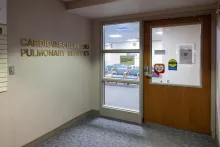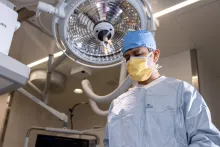Implantable Cardioverter Defibrillator (ICD)
- For all other requests:
- 1-800-777-8442
If you have a cardiovascular condition such as an irregular heartbeat (arrhythmia) or heart failure, your provider may recommend an implantable cardioverter defibrillator (ICD) to help improve symptoms and restore your heart’s rhythm.
An ICD is a small device that is surgically placed inside your chest or abdomen to help treat heart rhythm disorders and prevent sudden cardiac arrest. When your heart begins to beat irregularly, the device sends an electrical impulse into your heart to correct it. Depending on the type of arrhythmia you have, the impulse may be so mild you don’t even notice, or it may be a high-energy impulse, resulting in a noticeable shock (defibrillation).
University of Iowa Health Care electrophysiologists are extensively trained and perform hundreds of ICD implants every year. We are deeply familiar with these devices and know how to perform these procedures safely and successfully. We are also qualified to troubleshoot problems and answer any questions to help you make decisions about these devices with confidence.
We use the most up-to-date technology that lets us monitor your ICD while you go about your day. The device automatically alerts us if you experience unusual changes in heart rhythm. This remote monitoring reduces the number of in-person device checks you’ll need throughout the year and allows us to quickly evaluate your heart at the first sign of abnormal symptoms.
We also provide innovative biventricular ICDs (also known as cardiac resynchronization therapy device) to patients who have arrhythmia along with certain types of heart failure. These devices help restore the heart’s pumping ability, even among patients who might otherwise need a heart transplant.
Types of implantable cardioverter defibrillators
We offer three types of ICDs depending on your diagnosis. These include:
Traditional (transvenous) ICD: A traditional ICD contains a pulse generator that produces the electrical impulses and one or two leads (wires) that carry those impulses into the heart.
Subcutaneous ICD: This type of ICD is placed on the side of your chest, under the armpit. The lead runs along your breastbone, just underneath the skin. It remains outside your chest wall, so it’s near—but not inside—your heart. A subcutaneous ICD may be a good option when structural heart disease or other problems make it hard to place leads inside the heart.
Biventricular ICD: This device benefits people who have certain types of heart failure and who also need an ICD. It’s also known as cardiac resynchronization therapy (CRT) or a CRT-D device. It helps your heart’s bottom chambers work together to pump more blood. It also restores your normal heart rate during periods of tachycardia (a rapid heartbeat).
What to expect when you receive an implantable cardioverter defibrillator
ICD placement is a surgical procedure and usually takes a few hours to perform.
Your device placement will take place in our state-of-the-art cardiac catheterization lab. Here’s what you can expect:
- You’ll probably only need light sedation, which keeps you awake but comfortable. If you or your provider thinks you should have general anesthesia instead, so you’re fully asleep, we’ll discuss this with you beforehand.
- For traditional ICDs that have leads, we’ll guide them into your heart through your blood vessels. This requires a small incision near your collarbone. Then, we’ll place the pulse generator underneath the skin on your chest and connect it to the leads. This usually requires a two- to three-inch incision (and local anesthetic to numb the skin).
- For subcutaneous ICDs, we make one or two small incisions on the side of your chest. This creates a pocket for the device. Then we gently push the lead underneath the skin until it reaches your breastbone.
Your provider will let you know if you can return home the same day as your procedure or if you’ll need to stay overnight for observation.
Once your ICD is in place, you’ll need to keep a few things in mind:
- Be aware of any electrical or magnetic interference that could disrupt your device. For example, you may not be able to have MRI scans, and you should hold your cell phone at least six inches away from your device. Your provider will give you a complete list of equipment to avoid and guidelines to follow.
- If we’re monitoring your device remotely and it continues working properly, you only need an in-person checkup once each year.
- You may still need to take certain heart medications after you receive your device. An ICD alone can’t improve high cholesterol or high blood pressure.
- If you have an ICD for a life-threatening type of arrhythmia, you may have driving restrictions. Your provider will let you know if this applies to you.
- Depending on which type of ICD you have, the battery should last up to 10 years. When it’s time to replace the battery, you’ll undergo a minor surgical procedure.
You should quickly see an improvement in your arrhythmia or heart failure symptoms, so you feel and function more like your old self.
Who can benefit from receiving an implantable cardioverter defibrillator?
As part of your treatment plan, an ICD can help manage symptoms and provide relief if you have one of the following conditions:
- Ventricular arrhythmia
- Ventricular fibrillation
- Hypertrophic cardiomyopathy
- Long QT syndrome
- Brugada syndrome
- Congenital heart disease
- Previous cardiac arrest
- Dizziness, lightheadedness, or fainting
There may be other reasons your provider may recommend an ICD. Please talk to your provider if you have questions or think an ICD might be right for you.
Our Care Team









- Heart and Vascular


- Heart and Vascular

Not sure whether an implantable cardioverter defibrillator is right for you?
Locations and Offices



Related News



